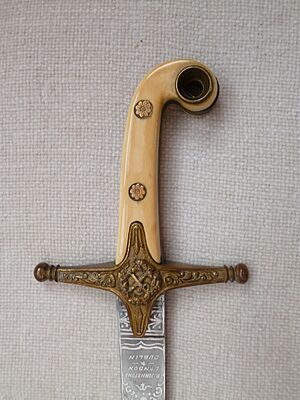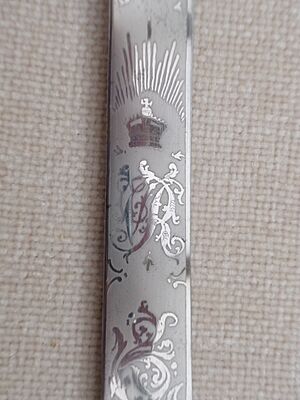Pattern 1831 sabre for General Officers facts for kids
Quick facts for kids Pattern 1831 sabre for General Officers |
|
|---|---|
| Production history | |
| Designed | 1831 |
| Manufacturer | Various |
| Produced | 1831 to present |
| Specifications | |
| Length | Blade - 31.0 in (79 cm) |
|
|
|
| Blade type | Curved, slab-sided, asymmetric point, false edge. |
| Hilt type | 'Mameluke hilt' with simple cross-guard. |
| Scabbard/sheath | Brass, wood liners, 2 loose suspension rings, later steel scabbards were introduced. |
The Pattern 1831 sabre for General Officers is a special sword used by high-ranking officers in the British army. It has been used continuously since 1831. This sword is a type known as a mameluke sabre. It's mostly for show and formal events, not for fighting.
A Sword with History
British and French army officers first saw swords like this during Napoleon's trip to Egypt (1798–1801). These swords were called 'mameluke sabres'. They were named after the Mamluk warriors of Egypt.
These swords became very popular with officers, especially those in high positions. Similar swords were also found in India, which also influenced British officers. At first, officers used these swords unofficially. They wore them for social events or even in battles.
Pictures from 1807 show British Hussar officers with these swords. By 1822, they became official dress swords for lancer regiments. Soon, other cavalry units also started using similar designs.
In 1822, generals and staff officers used a different sword. But then, the famous Duke of Wellington decided to make the mameluke sword the official one for generals. He really liked this type of sword himself!
What Does It Look Like?
The 1831 general officer's sabre was inspired by the mameluke swords already used by cavalry officers. It looks very similar to the sword used by the 3rd Light Dragoons, with only small differences in decoration.
The handle (hilt) and blade look a lot like the Turkish kilij sword. It has a simple cross-guard and a curved, 'pistol-grip' shaped handle. The blade has a "false-edge" (called a yelman) and a step near the back.
This sword is quite light because it's mainly for formal wear. The sword itself weighs about 1 lb 10.5 oz (750 g). Its scabbard (sheath) weighs about 1 lb 1 oz (480 g). The blade is about 31 inches (79 cm) long. It's flat on the sides and V-shaped. The last 12 inches of the blade are double-edged.
The flat sides of the blade are perfect for decoration. These decorations are made by acid-etching. They often include a crossed baton (a general's symbol) and sabre, the king or queen's special symbol under a crown, and designs of oak or palm leaves. Many blades also had a blank space where the owner could add their initials or family symbol.
The hilt has a cross-guard decorated with an oak leaf and acorn design. This design surrounds a crossed baton and sabre. The hilt parts are held together by two hidden bolts. All the metal parts of the hilt are made of shiny gilt-brass. The grip was originally made of ivory, from elephants or mammoths. Later, fake ivory was used. Modern swords only use synthetic ivory.
The 1831 sabre first came with two scabbards. One was black leather with fancy gold mounts for formal evening events. The other was a brass scabbard for all other times. Soon, the leather scabbard was not used, and the brass one became standard. The brass scabbard has wooden liners and two rings for hanging. In 1898, a steel scabbard replaced the brass one.
This sword pattern was also adopted by field marshals, royal equerries, and lords lieutenant. They had small changes in decoration. For example, field marshals had two crossed batons instead of one baton and a sabre. Royal equerries used the monarch's symbol. Lords lieutenant used symbols from their specific county, like a rose for England or a thistle for Scotland.
What Was It Used For?
Even though the blades of the 1831 sabre had to pass a special test, this sword was never meant for fighting. The test checked if the blade could return to straightness after being bent. But the blades were too light for cutting and too flexible for thrusting.
Throughout the 1800s, when generals were in battle, they used the fighting swords from their original army units. The 1831 sabre was, and still is, meant for formal occasions. Generals wear it for parades, inspections, and other events where they wear their full dress uniform.
See also
- Kilij




